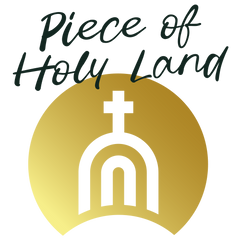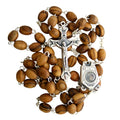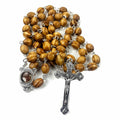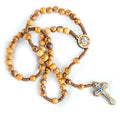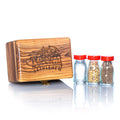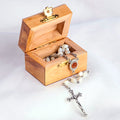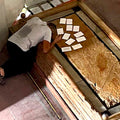Exploring the Rich Tapestry of Christian Symbols in Jerusalem
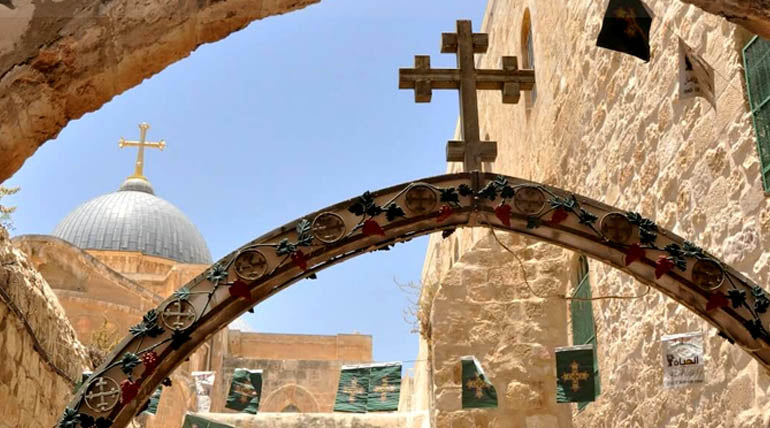
Understanding the Symbols: From the Jerusalem Cross to the Tau Cross
Introduction: The Cross as a Central Christian Symbol
The cross stands at the heart of Christian faith, symbolizing the crucifixion and resurrection of Jesus Christ. In Jerusalem, a city steeped in religious history, various forms of the cross and related Christian symbols are prominently displayed, each reflecting different traditions and theological emphases within Christianity.
The Jerusalem Cross: A Symbol of the Crusaders and Pilgrims
The Jerusalem Cross, also known as the Crusaders’ Cross, features a large central cross surrounded by four smaller crosses. This design was first used by Godfrey of Bouillon, the inaugural ruler of the Kingdom of Jerusalem. It has since become a symbol associated primarily with Catholic institutions.
The central cross represents Christ, while the four smaller crosses are interpreted to symbolize the Four Evangelists: Matthew, Mark, Luke, and John, who spread the Gospel to the four corners of the earth. Alternatively, they are seen as representing the five wounds of Christ during the crucifixion.
Today, the Jerusalem Cross is a popular emblem among pilgrims and is commonly found in jewelry and souvenirs, serving as a tangible connection to the Holy Land.
The Latin Cross: A Universal Christian Symbol
The Latin Cross, often referred to as the Roman Cross, is the most recognized symbol of Christianity. Representing the cross on which Jesus was crucified, it is a universal emblem of faith, sacrifice, and salvation. The vertical and horizontal beams intersecting in the middle remind believers of the unity between heaven and earth achieved through Christ’s sacrifice.
In Latin, it was referred to as crux immissa or crux capitata, indicating its classic design with the upright beam extending above the crossbeam. This simple yet profound shape has made it a powerful symbol across Christian denominations, especially in Roman Catholic, Protestant, and Anglican traditions.
The Latin Cross is not only a visual representation of Jesus’ crucifixion but also a reminder of the hope and redemption that comes through faith. In Jerusalem, the Roman Cross adorns churches, artifacts, and personal devotional items, serving as a constant reminder of Christ’s redeeming love and the unity it brings to the Christian faith.
The Orthodox Crosses: Diverse Symbols of Eastern Christianity
Orthodox Christianity is represented by a variety of Orthodox crosses also known as Eastern cross designs, each imbued with deep theological significance and cultural identity. These blessed crosses are prominently displayed in Jerusalem, reflecting the diverse traditions of Eastern Christianity and their ties to the Holy Land.
The Greek Orthodox Cross
The Greek Orthodox Cross is characterized by equal-length arms that intersect at the center, symbolizing the unity and balance of the Holy Trinity. This cross reflects the comprehensive nature of God’s love and power, serving as a core symbol for the Greek Orthodox Church. Prominently displayed in churches, mosaics, and ceremonial artifacts, it highlights the Greek Orthodox Church’s role as a major custodian of Christian heritage in Jerusalem. As the largest landowner among Orthodox denominations in the city, the Greek Orthodox community uses this cross to signify their enduring faith and historical presence.
The Russian Orthodox Cross
The Russian Orthodox Cross, a variation of the Eastern Cross, features three horizontal bars. The top bar represents the "INRI" inscription, which stands for "Jesus of Nazareth, King of the Jews" (John 19:19). The middle bar symbolizes the crossbeam where Jesus’ hands were nailed, and the slanted bottom bar reflects the footrest. In Russian tradition, this slanted bar conveys profound theological meaning: pointing upward toward the penitent thief who found salvation, and downward toward the unrepentant thief (Luke 23:39-43), representing judgment. Often adorned with inscriptions like "IC XC" (Jesus Christ) and "NIKA" (victory), this cross emphasizes Christ’s triumph over death and redemption.
The Budded Cross
The Budded Cross, a type of Eastern Cross also known as the Apostles’ Cross, features arms ending in three rounded buds. These buds represent the Holy Trinity and symbolize spiritual growth and flourishing faith. Deeply tied to the legacy of the Apostles, the Budded Cross celebrates their mission to spread the Gospel across the world. Its intricate design makes it a popular motif in cathedrals, vestments, and mosaics in Jerusalem, where it symbolizes the vibrancy and continuity of Christian faith.
The Tau Cross: Ancient Symbol Adopted by Christianity
The Tau Cross, resembling the Greek letter 'T', is one of the oldest cross forms, predating Christianity. It was later adopted by Christians and holds significant meaning, particularly within the Franciscan Order.
-
Biblical References: The Tau is mentioned in the Old Testament as a protective sign. In Ezekiel 9:4, a mark (interpreted as a Tau) is placed on the foreheads of the righteous to spare them from divine punishment.
-
Association with St. Francis: St. Francis of Assisi revered the Tau Cross, using it as a personal emblem and a symbol of his commitment to a life of penance and faith. He viewed it as a representation of the cross of Christ and a sign of salvation.
-
Symbolism: The Tau Cross signifies protection, redemption, and the fulfillment of God's promises. Its simple form also represents humility and the monastic life.
Today, the Tau Cross is worn by many as a sign of their faith and commitment to Christian principles.
The Custody of the Holy Land Emblem
The Custody of the Holy Land (Custodia Terra Sancta), established in 1217 by Saint Francis of Assisi, is a custodian priory of the Order of Friars Minor dedicated to safeguarding the Christian holy sites in the Middle East, particularly in Jerusalem. In 1342, through papal decrees, the Franciscans were officially appointed as custodians of these sacred places on behalf of the Catholic Church.
This symbol combines elements of the Jerusalem Cross with additional inscriptions and artistic flourishes, representing their mission to preserve and protect the Holy Land’s Christian heritage.

The Alpha and Omega: Symbols of Eternity
The Alpha (Α) and Omega (Ω), the first and last letters of the Greek alphabet, are often displayed alongside crosses in Jerusalem. Representing the beginning and the end, they highlight Jesus’ divine nature as declared in Revelation 22:13: "I am the Alpha and the Omega, the First and the Last, the Beginning and the End." This profound symbol conveys the eternal nature of Christ—the one who encompasses all of time and creation. Often used in church art, vestments, and mosaics, Alpha and Omega serve as a reminder of Jesus’ role as both Creator and Redeemer, framing the Christian story from Genesis to Revelation. In Jerusalem, these symbols are often paired with the cross, emphasizing Christ’s fulfillment of God’s eternal promises.

The Chi-Rho: An Early Christian Symbol
The Chi-Rho (ΧΡ) combines the first two letters of "Christ" in Greek, signifying the early Christian identification of Jesus as the Messiah. This ancient symbol is often found in mosaics, carvings, and artifacts across Jerusalem, particularly in places of worship and historical ruins. It represents Christ’s name, authority, and triumph over death.
Adopted by Emperor Constantine after his vision of the symbol with the words, "In this sign, you will conquer," the Chi-Rho became a military and spiritual emblem of victory. In Jerusalem, its presence is a reminder of the Church’s resilience and the early Christians’ faith amid persecution, making it a profound marker of the enduring legacy of Christ.

The Taphos: A Symbol of the Holy Sepulchre
The Taphos Symbol, exclusive to the Church of the Holy Sepulchre, symbolizes the sacred burial site of Jesus and embodies the Passion, Crucifixion, and Resurrection central to Christian faith. Its name, from the Greek "tau" and "phi," translates to "tomb" or "sepulchre." Following the 1054 East-West Schism, the Greek Orthodox Church gained significant property in Jerusalem, including the Holy Sepulchre, where the Taphos emblem prominently represents their tradition. The Brotherhood of the Holy Sepulchre, established in the 16th century, ensures the preservation of this emblem as a symbol of devotion and Christian heritage. The emblem is usually engraved on keystones of the many buildings built by the Greek Patriarchate in Jerusalem.

The Coptic Cross: The Heritage of Egyptian Christianity
The Coptic Cross, used by the Coptic Orthodox Church, features bold, equal arms often decorated with intricate patterns. It symbolizes the connection between Egyptian Christians and the Holy Land, particularly Jerusalem. Each arm of the Coptic Cross is often adorned with intricate details, representing eternity and the omnipresence of God.
Coptic Christians view the cross as a symbol of spiritual resilience, reflecting their long history of faith amidst persecution. In Jerusalem, Coptic crosses are prominently displayed in chapels and monasteries, serving as a testament to their unwavering devotion. The design often incorporates a circle, representing eternal life and the unity of the Church.
The Symbol of the Armenian Patriarchate
The Armenian Patriarchate’s emblem combines traditional Armenian crosses with additional elements, symbolizing their historical presence in Jerusalem and their dedication to preserving Christian heritage.
The Ichthys (Fish Symbol): An Early Christian Emblem
The Ichthys, or fish symbol, is one of the earliest symbols used by Christians, often found alongside crosses in Jerusalem. The term "Ichthys" is derived from the Greek word for fish (ἰχθύς) and serves as an acronym for "Jesus Christ, Son of God, Savior" in Greek (ἰησοῦς Χριστός Θεοῦ Σωτήρ).
The fish became a covert symbol during times of persecution in the early Church, allowing Christians to identify one another discreetly. It often appeared on tombs, catacombs, and artifacts as a representation of faith and the promise of eternal life. Additionally, the Ichthys symbol is closely associated with the Holy Eucharist, reflecting its intimate connection to the miracle of the multiplication of the loaves and fishes—a profound moment in Christ's ministry (John 6:1-14). This miracle not only prefigures the spiritual nourishment offered through the Eucharist but also emphasizes Christ’s compassion and provision.
In Jerusalem, the Ichthys is frequently depicted on mosaics, pottery, and other relics, underscoring its enduring spiritual significance. This symbol reminds modern Christians of their shared heritage and the resilience of faith throughout history.

Conclusion: The Diverse Expressions of Faith Through Crosses
Jerusalem's rich tapestry of Christian crosses and symbols reflects the city's diverse religious heritage and the various traditions within Christianity. Each emblem and cross—from the Jerusalem Cross to the Roman Cross, Eastern Cross, Tau Cross, and Budded Cross—tells a unique story of faith, history, and theology.
For pilgrims and visitors, understanding these symbols enhances the spiritual experience of exploring Jerusalem, offering deeper insights into the profound legacy of Christian devotion that has shaped the city over centuries.
SHARE:

